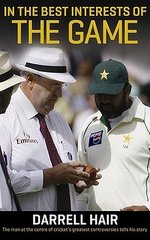In the Best Interests of the Game
Stuart Wark |Published: 2011
Pages: 322
Author: Hair, Darrell
Publisher: Harper Collins
Rating: 3.5 stars

The mere mention of the name ‘Darrell Hair’ can be enough to ignite the flames of hatred in certain areas of the cricketing world. He is possibly the most reviled umpire in recent history, and certainly no other on-field official has been at the centre of so much controversy since Fred Goodall and Shakoor Rana either decided, or had decided for them, that life was easier on the other side of the pickets. In particular, Hair’s decision to no-ball Murali for throwing in 1995 and his role in the 2006 Oval fiasco will probably be the main reasons he is remembered in years to come.
However, it is easy to focus purely on these events and forget that he stood in over 70 other largely uneventful Tests over 16 years, and was often rated over that period as one of the world’s best umpires by both his peers and team captains.
Hair released his first book titled “Decision Maker” in 1998 just after the ‘Murali affair’. He attempted to justify his position, which perhaps not unsurprisingly caused something of a commotion in world cricket circles and resulted in the ICC finding him guilty in 1999 of bringing the game into disrepute. With Hair’s somewhat involuntary retirement from officiating, he was released from the ICC’s rules that no active umpire could comment on the game, and therefore decided to release a follow-up work in 2011. The new autobiography is called In the Best Interests of the Game and a conscious decision was made by the review team to let the inevitable heat die down a bit so that an objective review could be conducted.
While his first book had a focus on Murali and throwing, this second work has much more of an emphasis upon the 2006 Test between England and Pakistan at the Oval. Naturally, Hair concentrates upon his side of the story. However he does make some persuasive arguments about the unfairness of his subsequent treatment, particularly when contrasted to that of his fellow umpire Billy Doctrove, who was equally responsible for the alleged ball tampering incident. The book does cover other issues including the ongoing saga of throwing, the introduction of a third umpire and technological reviews, his own personal cricketing pedigree, and Hair’s personal selections for World XI Test and One Day sides. These analyses are intelligently written and articulated from the perspective of someone as close to the action as you can be without actually being playing. As these sections are so interesting, it is slightly unfortunate that they take a back seat to the theme of the ‘2006 Oval Incident’ and subsequent fallout, which is more than 50% of the book.
As with any autobiography, the reader has to make a judgement as to how objective the writer can be, and how self-serving the resulting content may be. With this autobiography, the reader also has to determine how objective they personally are in respect to Hair’s motives and reasons. Consequently, it is quite hard in some ways to provide an overall mark for the book. If you feel Darrell Hair has been unfairly treated, victimised and scapegoated by the ICC, you will find that this autobiography confirms your viewpoint and I highly recommend you read it. If you think Darrell Hair is a “racist overbearing blowhard” (thank you forum chat rooms), I very much doubt reading this will change your opinion at all.
Overall, I found In the Best Interests of the Game an intriguing read, with Hair’s perspective and disclosures on many issues very informative. A final score of 3.5 stars, but with an asterisk for anyone with strong predetermined opinions regarding the author.






Leave a comment